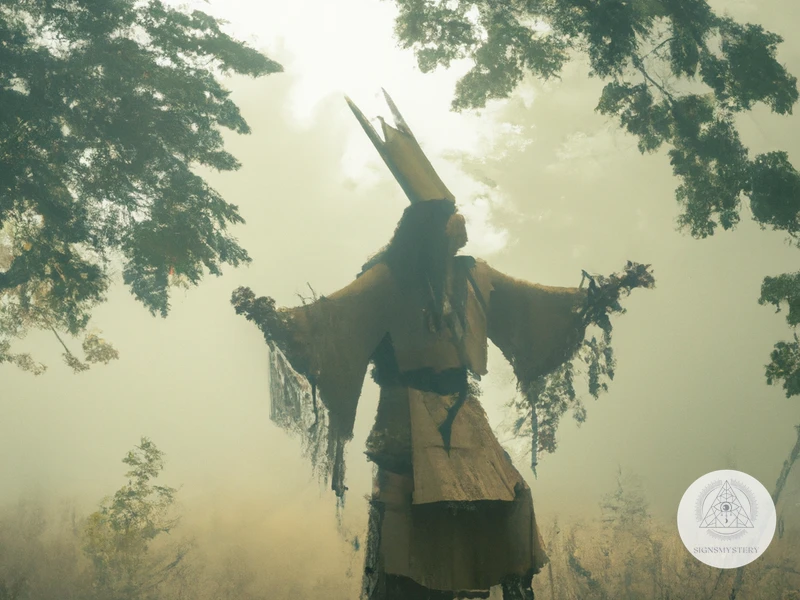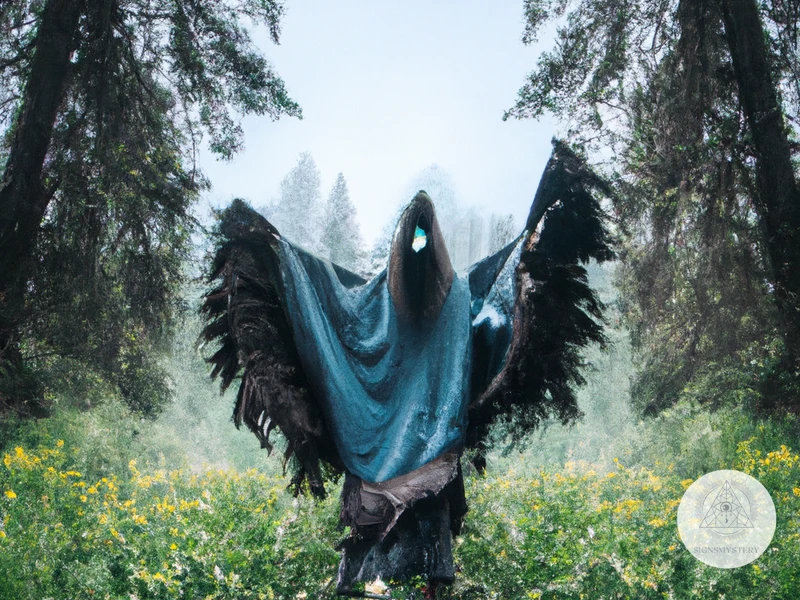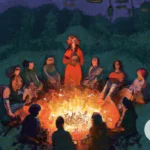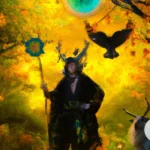Shamanism and mythology have been intertwined in traditional folktales for centuries, with shamans and mythological figures playing pivotal roles in these stories. The connection between shamanism and mythology is rooted in ancient practices that have been passed down from generation to generation, serving as a means of spiritual awakening and guidance. This article will dive into the complexities of shamanism and mythology in folktales, exploring their symbolism and role in modern culture. Through examining these topics, we will gain a deeper understanding of the rich history and contemporary value of shamanic practices and lore.
Defining Shamanism and Mythology
Shamanism and mythology are integral to understanding the origins of folktales. Shamanism is a spiritual practice that involves a practitioner who is able to enter a trance state and communicate with the spirit world to heal individuals and communities. On the other hand, mythology is a collection of stories that explain the origin of the world and teach moral and cultural values. In shamanic folktales, these two concepts are intertwined, and the stories often carry powerful symbolic meanings that offer guidance and insight into the human experience. Studying the connection between shamanism and mythology in folktales can provide a deeper understanding of traditional cultures and their beliefs and practices.
Exploring Folktales
Folktales are an essential part of ancient cultures around the world. They are the stories told by the elders that passed from one generation to the next. These tales portrayed the lives and beliefs of the people, as well as the natural and supernatural world around them. Through exploring shamanic folktales in traditional cultures, we can discover a rich history and understanding of the relationships between humans, nature, and spirits.
Shamanic folktales carry a deeper meaning than mere human entertainment. Various symbolic power is present in every story. By studying these motifs, we can unravel the secrets of shamanic visions and experiences. Exploring shamanic folktales can help us understand our contemporary existence, our society, and the whole world.
Retelling shamanic folktales is an art and craft in itself. Every culture has a unique way of expressing these stories. The themes are often the same, but characters and stories frequently differ from culture to culture. Exploring the themes of shamanic folktales can provide us with a glimpse of the similarities and differences between the traditional cultures that fabricated them. Ultimately, by exploring folktales, we gain insight into ancient wisdom that is still relevant and valuable today.
The Role of Shamanism in Folktales

Throughout history, shamanism has played an integral part in many cultures. In these societies, shamans were seen as spiritual healers, capable of journeying between the physical and spiritual worlds to find answers to questions that perplexed their community. These journeys often involved the use of hallucinogenic substances and drumming to induce a trance state. Folktales were often used as a way to pass down the teachings of shamanism from generation to generation.
In many shamanic folktales, the shaman must prepare himself before embarking on a journey. This preparation often consists of fasting, prayer, and avoiding certain foods. The shaman may also perform rituals to cleanse himself of negative energy and align himself with the spirit world. This attention to preparation is emphasized in the folktales to show the importance of taking the spiritual realm seriously.
Once the shaman is prepared, he is capable of travelling between different realms. In many shamanic folktales, the shaman will cross over into the spirit world to seek guidance, receive spiritual gifts or to retrieve lost souls. This journey can be perilous, and the shaman must use his intuition and spiritual knowledge to navigate the terrain of the spirit world. The shaman may encounter spirits who try to mislead him or obstacles that need to be overcome. However, upon returning to the physical world, the shaman is usually able to provide help to his community based on the knowledge he gained from his journey.
Many shamanic folktales draw on mythology to illustrate important life lessons. These stories often feature mythological figures such as gods and goddesses or other supernatural beings. The story may be set in ancient times, but its meaning is applicable to contemporary life. For example, a folk tale featuring a god who must overcome a series of challenges may provide a lesson in perseverance and determination.
Shamanism plays a crucial role in many folktales. Through these stories, people are reminded of the importance of preparation, the possibility of cross-realm travel and the wisdom they can gain by listening to the teachings of ancient mythology. These stories not only preserve the tradition of shamanism, but provide guidance for contemporary life as well. To learn more about shamanic folktales, check out our article on retelling shamanic folktales.
Preparing for the Journey
Before embarking on a shamanic journey, preparation is key. This includes creating a safe and sacred space, setting intentions, and invoking protective energies. Cleansing rites such as smudging or bathing can also be utilized to remove any negative energies. It’s important to approach the journey with an open mind and surrender any expectations or preconceived notions. The shamanic journey takes place in a non-ordinary reality, where the shaman acts as a mediator between the physical and spiritual realms. The journey can offer deep insight, healing, and connection with the divine. However, guidance and support from an experienced shaman is recommended for a safe and transformative experience.
Traversing Realms with Shamans
Shamans are often depicted as intermediaries between worlds, capable of traversing dimensions to communicate with spirits and receive guidance. This ability is a central theme in many folktales where the shaman is the protagonist. Traversing realms requires preparation and knowledge of spiritual customs and traditions.
In folktales, the shaman begins by embarking on a journey into an altered state of consciousness. The journey may be induced by drumming, chanting or ingesting psychoactive plants. This altered state allows the shaman to communicate with spirits and travel to other realms. In some cases, the shaman may encounter obstacles that must be overcome before reaching the desired destination.
The shaman’s ability to traverse realms is not just limited to spiritual dimensions. In some folktales, shamans can also travel to the land of the dead to communicate with ancestors. This journey requires special knowledge and preparation, as the land of the dead is a dangerous place for the living.
Traversing realms with shamans is not just a theme in folktales, but also a practice that is still used in contemporary shamanic traditions. Modern techniques for inducing an altered state of consciousness include meditation and breathwork. The goal is still to communicate with spirits and receive guidance, but the means of achieving that state have evolved.
The ability to traverse realms with shamans is a fascinating and complex aspect of shamanic traditions. It demonstrates the power of spiritual exploration and the belief that there is more to reality than what can be seen with the naked eye.
Using Ancient Mythology to Guide Contemporary Life
Mythology has long been used as a source of moral and ethical guidance, and it continues to be relevant today. The ancient stories and myths of different cultures provide insights into the human condition and offer guidance on how to live a purposeful life. Indeed, many of these stories have been passed down through generations and remain a prominent feature of popular culture even today.
One of the ways in which mythology can help guide contemporary life is by offering elements of storytelling that speak to universal themes. For example, the ancient Greek myths of Narcissus and Icarus illustrate the dangers of hubris and pride. By exploring these myths, we can gain a deeper understanding of these themes and how they affect the human psyche.
Mythology can help us find meaning in our lives and connect us to something greater than ourselves. Through exploring the mythologies of different cultures, we can find common threads that connect us all as human beings. This can help inform our sense of purpose and guide us as we navigate the complexities of the modern world.
The archetypes found within mythology can serve as symbols for deeper psychological or spiritual truths. For instance, the Greek goddess Athena represents wisdom, strategy, and intelligence. By invoking her archetype, we can connect with these qualities within ourselves and aspire to live up to these ideals.
Mythology can help us understand our place in the world and can provide a sense of perspective. Through exploring the vast body of myths and stories that exist across cultures, we can come to see ourselves as part of a larger, interconnected whole.
The use of ancient mythology to guide contemporary life is an effective way to find meaning, connect to something greater than ourselves, and gain wisdom and insight from universal themes. It offers a unique way to explore the depths of our own psyche and to connect with the world around us in a profound and meaningful way.
The Symbolism of Mythological Figures
Mythological figures play a significant role in the world of shamanism. The symbolism behind these figures is rich, complex, and deeply rooted in the belief systems of many cultures.
One of the most prominent mythological figures found in shamanic folklore is the trickster. The trickster archetype is characterized as a mischievous, witty, and unpredictable figure who often appears in the form of an animal. Tricksters are known for their ability to blur the line between good and evil, and their tales often serve as cautionary tales for those who seek to challenge societal norms.
In shamanism, the trickster is seen as a powerful force that can help shamans navigate spiritual realms. The trickster’s unpredictable nature and ability to outwit others make them natural allies in the spirit world. Shamans will often use trickster symbolism, such as coyotes or ravens, to represent their connection to the spirit realm.
Another common symbolism found in shamanic mythology is that of the shadow self. The shadow self represents the darker, more primal aspects of the human psyche. In shamanism, confronting and integrating one’s shadow self is seen as a crucial step towards spiritual enlightenment.
Shamans may use mythological figures such as demons or monsters to represent the shadow self in their journeys. By facing and understanding their shadow self, shamans are better able to understand their own emotions and motivations, and in turn, connect more deeply with the spiritual realm.
Here are some examples of mythological figures and their associated symbolism in shamanic folklore:
| Mythological Figure | Symbolism |
|---|---|
| Coyote | Trickster, shape-shifter |
| Raven | Trickster, wisdom, messenger of the spirit world |
| Serpent | Transmutation, transformation, healing, fertility |
| Demon | The shadow self, fear, temptation |
It is important to note that these mythological figures can have different meanings and associations in different cultures. The symbolism of a particular figure may be interpreted differently by different shamans or spiritual practitioners.
The symbolism of mythological figures in shamanism is rich, complex, and deeply rooted in the belief systems of many cultures. The trickster archetype and the shadow self are two of the most commonly used mythological figures in shamanic folklore, and their symbolism provides an avenue for shamans to navigate the spiritual realm.
The Trickster Archetype and Shamanism
In many folktales and mythologies, there is a character known as the Trickster, who uses their cunning and wit to disrupt social norms and challenge established authority. The Trickster archetype is closely linked to shamanism, as both involve a rejection of mainstream culture and a search for alternative ways of understanding the world. The Trickster is often seen as a figure who can help people communicate with the spirit world and access hidden knowledge. However, the Trickster is also a source of danger and unpredictability, and their actions can have both positive and negative consequences. In shamanism, the Trickster is a powerful force that can help people confront their fears and overcome their limitations, but also one that must be approached with caution and respect. By exploring the role of the Trickster in shamanism, we can gain a deeper understanding of the complex relationship between myth, folklore, and spiritual practice.
The Shadow Self and Shamanism
In shamanic practice, the concept of the shadow self plays a significant role. The shadow self represents the darker aspects of an individual’s personality that are often repressed or denied. Shamanism recognizes the importance of accepting and integrating these aspects in order to achieve wholeness and balance.
Shamans believe that by confronting and working with the shadow self, individuals are able to release negative energies and emotions that may be holding them back. This can lead to a greater sense of self-awareness, inner peace, and spiritual growth.
One popular shamanic technique used to work with the shadow self is called “shadow work”. This involves entering altered states of consciousness through methods such as drumming or chanting, and then exploring the shadow self in a safe and controlled manner.
Through shadow work, individuals can come to a better understanding of their own fears, insecurities, and negative patterns of behavior. This can allow them to make positive changes in their lives and embrace their true selves.
It’s important to note that working with the shadow self can be a difficult and intense process. It’s crucial to approach it with respect, caution, and the guidance of an experienced shaman or therapist.
In mythology, many figures are associated with the shadow self or represent aspects of it. Examples include the Greek goddess Hecate and the Norse god Loki, who both embody chaos, trickery, and transformation.
Shamanism recognizes the importance of acknowledging and working with the shadow self in order to achieve balance and harmony in one’s life. By embracing all aspects of oneself, including the shadow self, individuals can unlock their full potential and live authentically.
Shamanism in Popular Culture

Shamanism has been a part of human culture for centuries, and as a result, it has made its way into popular culture in various forms. From movies to video games, the themes of shamanism have been used to create compelling stories. In this section, we will explore the ways shamanism has been depicted in popular culture.
Shamanism is a popular theme in books and films, particularly those set in indigenous communities. In these stories, shamanic practices are often depicted as the key to understanding the underlying mysticism and supernatural events that occur in the story.
One popular example of this is the Harry Potter series, where the use of magic is heavily influenced by shamanic practices. The character of Professor Dumbledore, for instance, functions as a shamanic figure for Harry and his friends, leading them on a transformative journey of self-discovery.
Another example is the film “Avatar,” where the Na’vi people’s connection to their environment is depicted as being deeply rooted in shamanic practices. The shamanic figure of Mo’at plays a crucial role in helping
Subscribe to Our Newsletter
Sign up to receive the latest news and updates.
While the portrayal of shamanism in popular culture has brought greater awareness of its practices, there is also a concern about the impact that modern interpretation has had on its traditional forms. Shamanic practices are often depicted in a sensationalized way, with emphasis on the use of drugs and other mind-altering substances. This type of portrayal can often be misleading and undermine the true depth and complexity of shamanic practices.
Additionally, the commercialization of shamanic practices, such as the selling of “shamanic tools” or courses on shamanism, has led some to question whether it is being exploited for financial gain rather than being appreciated for its cultural and historical significance.
Shamanism in popular culture has the potential to bring greater awareness of these ancient practices, but it also carries the risk of being oversimplified and commercialized. It is important to respect the origins of shamanism and approach it with an open mind and a willingness to learn from those who have dedicated their lives to the practice.
The Use of Shamanism in Books and Films
Shamanism has become a popular subject in books and films, offering audiences a window into the vibrant world of ancient spirituality. From novels like “The Teachings of Don Juan” by Carlos Castaneda to blockbuster films like “Avatar,” shamanic themes are explored in colorful and imaginative ways. These stories often contain familiar shamanic motifs like visionary journeys, shape-shifting, and ritual practices. They also offer a tantalizing glimpse into the symbolism of shamanism, with figures like the trickster and the shadow self making appearances. Additionally, many modern authors and filmmakers use shamanism as a way to explore contemporary issues like environmentalism and social justice. While some may criticize the use of shamanism as cultural appropriation or simply inaccurate, the popularity of these books and films reflects the enduring allure of shamanic wisdom for many people today.
The Effect of Modern Interpretation on Shamanism
The effect of modern interpretation on shamanism has been significant. With the growth of globalization and increased exposure to diverse cultures, traditional shamanic practices have been integrated into several modern interpretations. This has led to both positive and negative ramifications.
On the one hand, modern interpretations of shamanism can provide a fresh perspective on traditional practices, helping to keep them alive and relevant. For example, the use of shamanic practices in psychology has led to the development of shamanic healing therapy which has shown promising results in treating mental health disorders.
On the other hand, modern interpretations can also lead to cultural appropriation and misrepresentation. It is essential to respect the cultural significance and context of shamanism. Several individuals and groups have claimed to practice shamanism without proper training or knowledge, which can lead to exploitation of the tradition.
Many modern interpretations of shamanism tend to focus only on a particular aspect, such as using entheogens for spiritual experiences. This emphasis can oversimplify the complexity and depth of traditional shamanic practices.
While modern interpretation can provide a new outlook on traditional shamanic practices, it is crucial to approach the tradition with respect and cultural sensitivity. Understanding the cultural context, history, and purpose of shamanism is essential to avoid misinterpretation and exploitation.
Connecting with Shamanism Today
Shamanism is not just a thing of the past, but a living tradition that has been practiced for thousands of years and continues to be practiced today. Despite centuries of persecution and suppression, shamanic techniques and beliefs have persisted and modern practitioners have found ways to adapt them to contemporary life. Here are some ways in which people can connect with shamanism today:
One way to connect with shamanism today is by engaging with the folktales and myths that contain its wisdom. These stories have been passed down from generation to generation and contain valuable insights into the shamanic worldview. By reading and studying these tales, we can gain a deeper understanding of the interconnectedness of all things and the importance of honoring the natural world.
It is also important to recognize the role that colonization and globalization have played in erasing or distorting indigenous cultures and their stories. By supporting the preservation and celebration of these stories, we can help to counteract these forces of cultural erasure and contribute to the revitalization of indigenous traditions.
Another way to connect with shamanism today is by exploring contemporary shamanic practices. Many modern practitioners have adapted traditional shamanic techniques to suit contemporary contexts, such as using shamanic journeying to address modern psychological issues like anxiety and depression.
Some contemporary shamanic practices also incorporate elements of other spiritual traditions, such as yoga, Buddhism, and paganism, in order to create a more holistic approach to healing and spirituality.
Contemporary shamanic practitioners can be found in many different places, such as yoga studios, spiritual retreat centers, and online communities. It may take some research and exploration to find the right practitioner or community, but the benefits of connecting with shamanic wisdom can be profound.
Shamanism is not a relic of the past but a living tradition that continues to evolve and adapt to contemporary life. By engaging with shamanic folktales and exploring contemporary shamanic practices, we can connect with this ancient wisdom and find new ways to honor the natural world and live more fulfilling lives.
The Importance of Preserving Folktales
The preservation of folktales is crucial in keeping traditional knowledge alive and passing it down to future generations. These stories hold valuable lessons and insights into the beliefs and practices of cultures around the world. By preserving folktales, we can connect with the wisdom of our ancestors and learn from their experiences. Sharing these stories can also promote cultural exchange and understanding. As humans, we have been passing down stories from generation to generation for thousands of years. It is important that we continue to do so, not only to honor our heritage but also to shape our future. As we face modern-day challenges, the lessons contained in folktales can guide us towards a more harmonious way of life.
Contemporary Shamanic Practices
Shamanism is not just a thing of the past. In fact, modern-day shamans continue to thrive in many different parts of the world, providing spiritual guidance to those in need. Contemporary Shamanic Practices are a testament to the fact that shamanism is still relevant in modern times.
One such practice is Ayahuasca, a traditional South American brew which is said to bring about spiritual awakening and healing. Ayahuasca ceremonies are often conducted by trained shamans, who sing Icaros (traditional songs) and give guidance to participants during the ceremony.
Another contemporary shamanic practice gaining popularity is the use of drumming as a form of meditation. Drumming circles are often led by modern-day shamans, who help participants to connect with their inner selves and the spirit world. It is believed that the rhythmic beating of drums can help to induce altered states of consciousness, allowing individuals to access deeper levels of understanding and healing.
Many contemporary shamans may also incorporate other ancient healing practices, such as the use of crystals or herbs, into their work. They also may use modern technologies, such as biofeedback machines, to help clients achieve a deeper state of relaxation and spiritual connection.
It is important to note that while contemporary shamanic practices may incorporate different elements and technologies, they still honor the core principles of shamanism. These practices are still centered around the belief that everything in the universe is interconnected and that spiritual healing is an integral part of physical and emotional wellbeing.
Contemporary Shamanic Practices demonstrate that shamanism has evolved with the times, while still maintaining its central principles and values. As individuals continue to seek spiritual guidance and healing in modern times, shamanism will continue to play an important role in providing them with the support they need.
Conclusion
In conclusion, the connection between shamanism and mythology in folktales is undeniable. Folktales have been a way for cultures to pass down their beliefs and traditions from generation to generation. Shamanism has played a significant role in these stories, serving as a guide for the journey and a means of communication between realms.
Through shamanic practices, individuals are able to connect with the spiritual world and the mythological figures that reside within it. The symbolism of these figures can help individuals better understand their own lives and provide guidance for their journey.
While shamanism has been present in folktales for centuries, it has also made its way into popular culture. Books and films often depict shamans and their journeys, bringing these traditions to a wider audience. However, it is important to note that modern interpretations of shamanism may not always be accurate or respectful of its cultural significance.
To truly connect with shamanism, it is important to preserve and honor the folktales and practices that have been passed down for generations. Contemporary shamanic practices also offer opportunities for individuals to explore this ancient tradition and incorporate it into their lives in a meaningful way.
In summary, shamanism and mythology have a deep connection in folktales, serving as a guide for the journey and providing insight into the spiritual world. By understanding and honoring these traditions, individuals can connect with the divine and gain a deeper understanding of themselves and the world around them.
Frequently Asked Questions
What is Shamanism?
Shamanism is an ancient spiritual practice found in many cultures around the world, in which a shaman connects with the spiritual world to access knowledge, healing, and guidance for themselves and others.
What is Mythology?
Mythology is a collection of traditional stories and beliefs that are often based on gods, supernatural beings, and events that cannot be explained by natural laws. These stories often shape the beliefs, values and traditions of cultures.
What are Folktales?
Folktales are traditional stories passed down through generations by word of mouth. They often feature supernatural elements, moral lessons, and symbolic characters.
What is the role of Shamanism in Folktales?
Shamanism often appears in folktales as a means to connect with the spiritual world, navigate mysterious realms, and heal the sick. Shamans serve as guides for the protagonists on their journeys.
What is the symbolism of mythological figures?
Mythological figures often represent archetypes, such as the trickster or the shadow self. These archetypes represent aspects of the human psyche and serve as symbols for psychological growth and transformation.
What is the Trickster Archetype?
The Trickster Archetype is a character who breaks the rules, disrupts order, and challenges authority. In mythology, tricksters often invoke laughter, but they can also embody chaos and danger.
What is the Shadow Self?
The Shadow Self is a psychological concept that represents the repressed or denied aspects of a person’s personality. It can include things like fears, desires, and impulses that a person wishes to keep hidden from others and even themselves.
What is the effect of modern interpretation on Shamanism?
Modern interpretations of shamanism can sometimes change or distort the original meaning and practices of the tradition. They can also lead to cultural appropriation, where non-indigenous people appropriate or exploit aspects of shamanism for personal gain.
What is contemporary shamanic practice?
Contemporary shamanic practice involves using the principles of shamanism to guide personal growth, healing, and spiritual development. This can include things like journeying, dreamwork, and other practices that connect with the spiritual world.
Why is it important to preserve Folktales?
Preserving folktales is important because they provide a link to the past and serve as a connection to cultural heritage. They also offer valuable lessons and insights into the human experience that can be applied to contemporary life.










